“The religion whose savior is born in the humblest circumstances, who during his three year pubic ministry consorted mainly with lowlifes, criminals, publicans and the possessed and whose harrowing death on the cross was, in the words of St. Paul, a Stumbling block to the Jews and Foolishness to the Greeks (Corinthians I, 23), is a religion which ought to shock the genteel assumptions of each generation of its followers. Caravaggio was the first great religious painter to understand this paradox.”
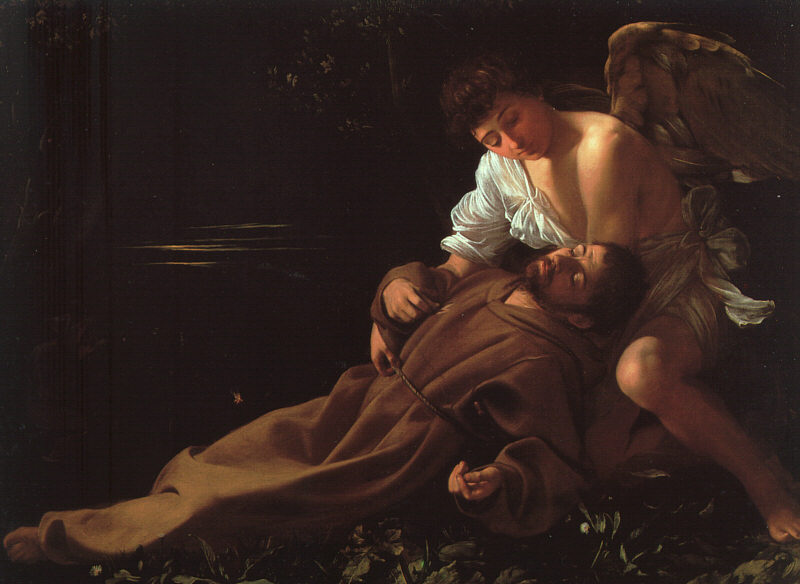
"Caravaggio paints a typically luscious boy who just happens to have a pair of wings stuck to his back cradling a swooning saint in St Francis in Ecstasy. Ecstasy as a theme isn’t unknown in religious art, of course, but Renaissance painters usually showed St Theresa doing the fainting. Caravaggio was following a different muse." This was Caravaggio's first religious painting. Such a contrast of light and shadow, "chiaroscuro" became a hallmark of Caravaggio's mature work, and an important source of dramatic power.
His formula is a shallow space crowed with a few significant figures and maximum concentration on them. He aimed at the maximum emotional sympathy of the viewer inviting him to enter the painting or making the painting seem to push out of the canvas (See the first Supper at Emmaus, illustrated at the top of the page). He is the master of dramatic theatrical lighting spotlighting the main figures faces while their bodies and those around them are in shadows.” (Richard Phelan )
Michelangelo Merisi da Caravaggio, known simply as Caravaggio, was an Italian artist at the turn of the 17th century whose influence rivals that of Michelangelo when it comes to Western art. But while Michelangelo was known for a devotion to the idealized form of body and Christian spirit, Caravaggio was known for his ability to realistically capture moments of human emotion, often in violent depictions of Christianity’s sacred stories.
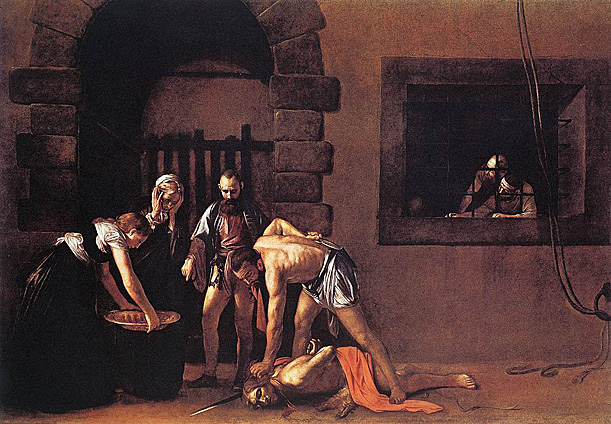
The Beheading of Saint John the Baptist. 1608. In the dank gloom of a prison, the saint has just been murdered and Salome reaches down for his head. Caravaggio daringly threw the composition off balance, concentrating the figures, and the light that illuminates them, on one side of the canvas.
The life of Caravaggio was short and intense, characterized by bouts of brawling, time in jail, banishment, and homicide. His paintings are typified by a dramatic manipulation of light (chiaroscuro); reliance on human models, many with multiple appearances in his paintings; by a blatant homoerotic content ; direct painting without preliminary drawings, a non-sentimental approach to religious art, and an eerie “photorealism” that extends to portraiture, various objects including musical instruments, scores, and plant material.
The last works of Leonardo, Michelangelo and Titian all seemed to question the very foundations of their own achievement as well as the goodness of this world. Each artist spent his last years working in an apocalyptic mode. Leonardo’s many drawings of a Watery Deluge which destroys the world, Michelangelo’s Last Judgment and Titian’s Crowning with Thorns and his last Pietà are works of extraordinary doubt, despair, and disillusionment. In reaction, younger painters either tried to outdo the late works or moved into areas of fantasy avoided by the High Renaissance, breaking rules of decorum, of subject matter, and of unity, known as the Mannerism movement. Caravaggio turned this situation around. He put European painting back on track returning the focus to what we all perceive and what we all know. But he did it with a twist.
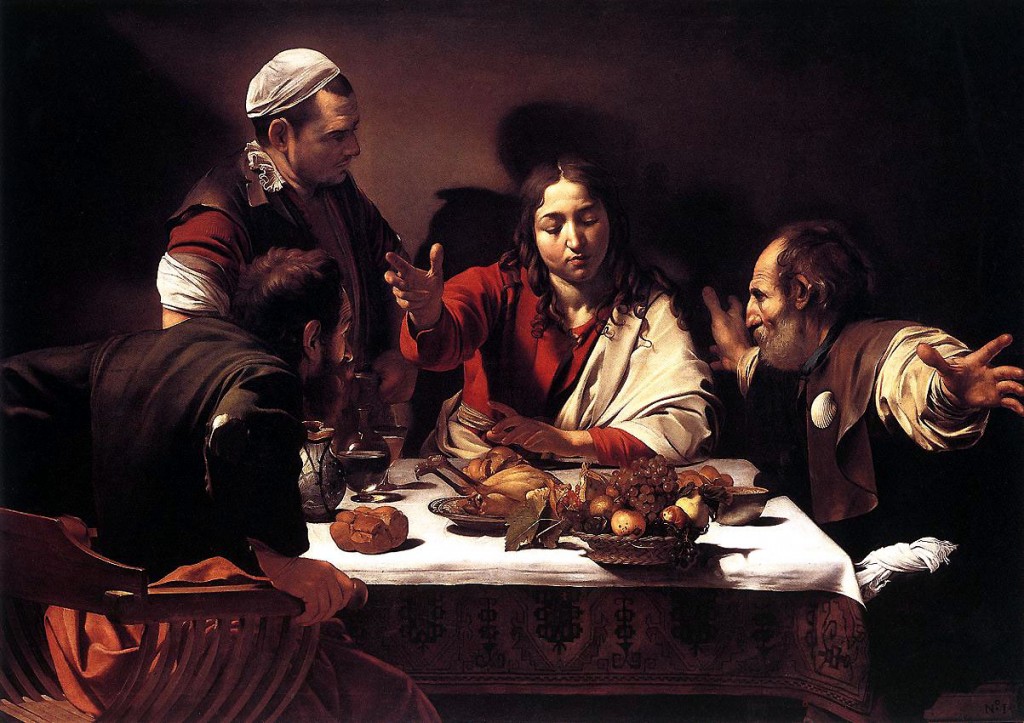
Caravaggio. Supper at Emmaus. London. "Caravaggio involves us in the Emmaus scene through what Walter Friedlaender calls ‘realistic mysticism’. Friedlaender argues that Caravaggio’s religious depictions were of a piece with the religious movements of his day. The popular emphasis that Caravaggio’s contemporary Philip Neri and the Oratorians gave to the Exercises of St Ignatius, along with the reforms introduced by the newly established religious congregations of the Barnabites and the Theatines, awakened ‘a simplicity of faith and a mystic devotion which gave each individual a direct and earthly contact with God and His Mysteries..."
Caravaggio was destined to electrify painting in the early years of the 17th century, causing shockwaves which would be felt throughout most of Europe as each generation of painters caught on to his revolution in easel painting. The Carravaggists (early followers in Italy, Netherlands, Flanders and Spain) were followed by the generation of giants, Rubens, Rembrandt, Vermeer and Velázquez, each borrowing from the man who painted with a striking directness that compels the spectator to participate in the action….
Realism is a term that enjoys a considerable degree of cultural realtivity, as any word must when it has, at different times and by different writers, been attached to such very different painters as Velazquez, Bruegel, Courbert, and so on. It does not mean an unedited transcription of reality. But it does entail the consistent registration of what is extracted as meaningful from that ceaseless tattoo that the world drums on the eyeball. Realism is choice, and the limits of choice vary from painter to painter and from culture to culture. To a modern photo-realist, Courbet’s decision to base his masterpiece of realist painting, “Le Rencontre-Bonjour, M.Courbet”, on a popular woodcut would seem an abdication of a realist,s duty. Probably Courbet would have looked askance at some of the dramatic devices that Caravaggio ( 1571-1610 ) loved: the magnificent artifice of pose and lighting in his mature religious works, no less than the theatrical nostalgia of his early works.
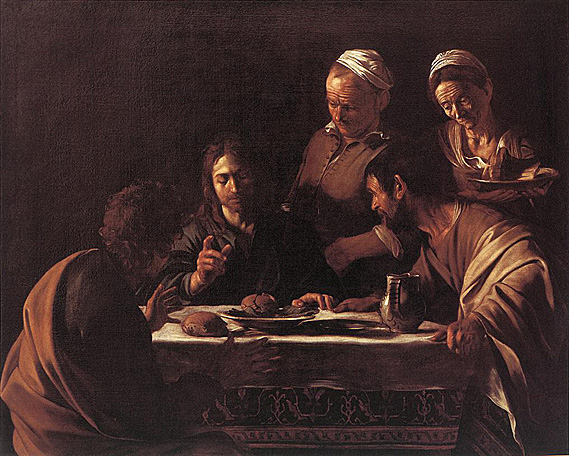
Supper at Emmaus 1606. Milan. "This second Supper at Emmaus was painted five years after the first, and just after Caravaggio had killed Ranuccio Tomassoni in a fight. The brilliance, the boldness and the dazzling colours of the earlier Supper yield to dark brown, blue-green shadows and evening light. The risen Christ, whose face is bearded, is ‘a mature man whose weary expression suggests both the weight of his recent ordeal and of the endless mission to save humanity from its own folly’.19 In the Milan Emmaus, Caravaggio, exiled for killing Tomassoni, turned his thoughts ‘to the extreme price
by those excluded from God’s grace’,20 even if not long after the killing Caravaggio was made a Knight of Malta, an honour which Pope Clement VIII, who knew what Caravaggio had done, made no attempt to prevent.21 The killing of Tomassoni was anything but premeditated. Langdon describes the Milan Emmaus as ‘a tender portrayal of confidence in a redemptive Christ, who gently renews hope in the despairing disciples, and brings comfort to the poor’"
For nostalgic they are. Art feeds on art, and this is clearly evident in such Caracvaggios as “The Musicians”, “The Fortune Teller”, and the “Card Sharps”, all from the mid 1590′s. Their mode is Venetian, Giorgionesque, in fact. Small groups of intimate yet shadowy colloquy; the air of expectation and the nuances of melancholy; the fancy dress. Caravaggio’s early figures, when clothed, are not dressed like Romans in the last decade of the sixteenth century.
“Hee is counted no gentleman amongst them that goes not in blacke,” Thomas Nashe and “The Unfortunate Traveler” again: “they dress theyr jesters and fooles only in fresh colors , and saie variable garments doe argue unstaiednesse and inconstancy of affections…” The fashion was austere and Spanish. “Did Caravaggio really dress up his young friends,” Roger Hinks wondered,”in properties found in some old garret, or picked up in the Campo dei Fiori? And did they really preen themselves on the Piazza Navona in this fantastic raiment, to distinguish themselves… from respectable citizens in sober black?” In 1953, when that was written, the obvious answer would have been no. Today, one cannot be so sure; it well might be imagined that the costume side of Caravaggio’s “giorgionismo” was on the streets in 1595.
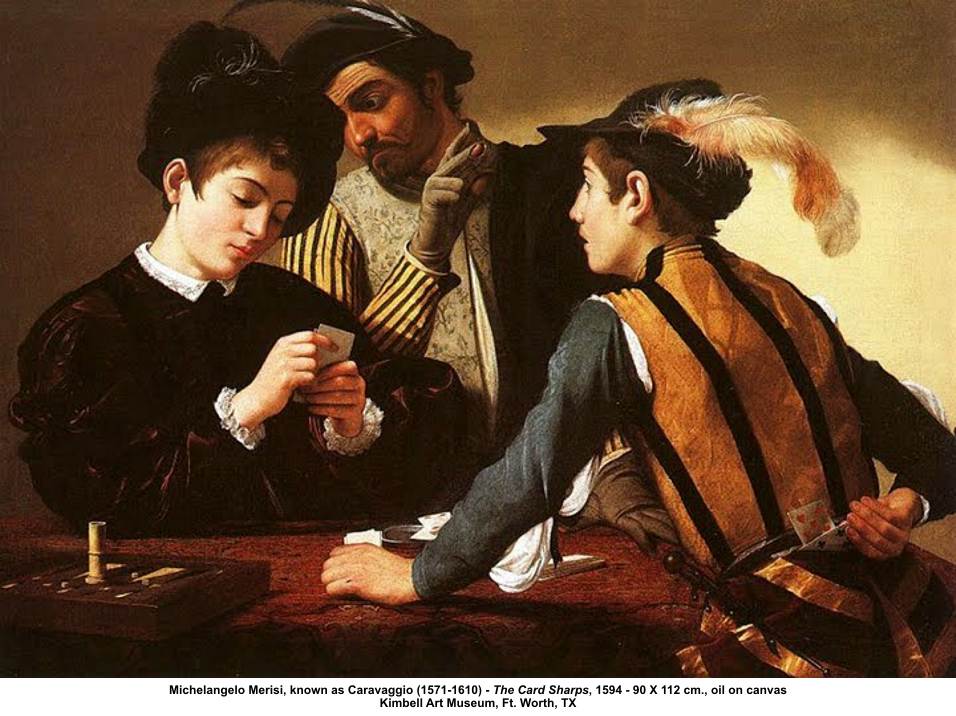
The Cardsharps. 1596. "First translated into paint by the Italian master Caravaggio, images of cardsharks and cheats became immensely popular in the early seventeenth century. The narrative itself held dramatic appeal, but these paintings also carried various meanings and associations for a seventeenth-century audience."
What Caravaggio’s critics objected to as his realism was, as the documents of the time abundantly show, his lack of decorum. In answer to the stylistic demands of late Mannerism, with its serpentine figures, stylish elongations, prissy conceptualism, and general recoil from the juices and fats of life, Caravaggio proposed a direct and violent pictorial system that subordinated detail to the immediate, tangible, sculptural reality of the figures; figures drawn not from pattern books but from models picked up on the streets.
Gradually, the shallow, neutral space, gray or beige, against which Caravaggio posed those ephebi turns into a Black Hole, a continuum of darkness from which light, like divine illumination, rescues the Mary’s and martyrs , the crones and executioners, freezing their gestures with the shock of a flash. Light renders the forms concrete, raking across each knot of muscle and wrinkle of cheek. But it also transfigures; it isboth a judgement and a reprieve from the eroding dark. That blackness is the constant in the later work. Beneath the glaring varnish and blisters , time’s graffiti on its skin, are infinite subtleties of void lain into void. Caravaggio, the master of Eros, now becomes the servant of Thanatos. …
Caravaggio’s revolution consists in two innovations. As a painter of mostly devotional art, he necessarily focused on figures and events from the New Testament but he took more seriously than any painter since Masaccio the mundane yet monumental quality of Christianity. The typical Caravaggio religious painting increased the mundane quality of the events by using Roman street people as the model for the Apostles and Mary. But he also increased the monumentality of the paintings by larger than life proportions, highly theatrical lighting and by crowding his significant figures into an extremely shallow space thus capturing the attention of the spectator with dramatic and immediate effects.
Some of Caravaggio’s canvases were at first rejected by the Church as being inappropriate (it was said that he used the body of a dead prostitute fished out of the Tiber as his Mary in the Death of the Virgin), but he had a highly sophisticated audience.Yet Caravaggio’s heightened realism eventually won over the his patrons because realism made a certain kind of sense to the Post Reformation Church which was interested in using art to bring the people back to the Church.
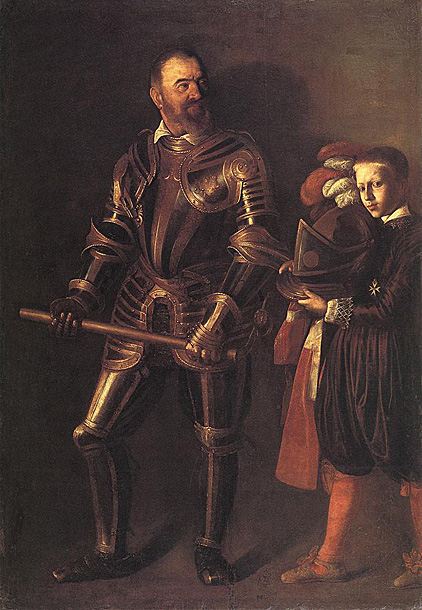
Alof de Wignacourt. 1607. "The boy's lively expression and alert gaze make him an attractive subject in his own right, to the extent that he was several times copied by later artists visiting Malta. Wignacourt, encased in splendid black and gold Milanese armor, stares upwards and outwards out of the frame in a dignified manner that invites the viewer to gaze upon him in awe, leaving the page, with his look of boyish interest, as the sole thoroughly human presence, and a far more sympathetic one than the self-conscious man of steel. The double-portrait with the pageboy was an unusual combination for the time. It may have been ordered by Wignacourt to stress the dignity of his court, or Caravaggio may have been inspired by a painting by Titian that he could have seen in his youth in Milan, The Speech of Alfonso d'Avalos, showing the Spanish governor of the city addressing his knights with a page beside him holding his helmet."
… The way station between these modes of vision is his “Saint Francis in Ecstasy” it is dark , and the saint falls back into the arms of an angel in a peaceful swoon of delight. The angel’s shoulder and leg are naked. His right index finger is hooked, a very Caravaggesque touch, under the saint’s robe girdle. Moonlight caresses their skin and draperies and sends thin streaks of light across the lake behind them. Iconographically, it is a very unusual painting. The customary appurtenances of Saint Francis’ vision; the rolling eyeballs, the open mouth, the kneeling posture, are gone. What remains, however, is a fascinating excursus on the interwoven themes of spiritual and erotic ecstasy that had long been present in Catholic visionary literature, and were to reach their most explicit plastic form in Bernini’s “Saint Theresa”. Nor is it impertinent to link Caravaggio’s image to the nexus of death and love that Michelangelo signified in his Vatican “Pieta” .
Saint Francis’ ecstasy is also a kind of death; the ego dies when Christ enters. It is hardly surprising, then, that one of the numerous copies of Caravaggio’s painting once went to Spain with the title “Death of Saint Francis”.
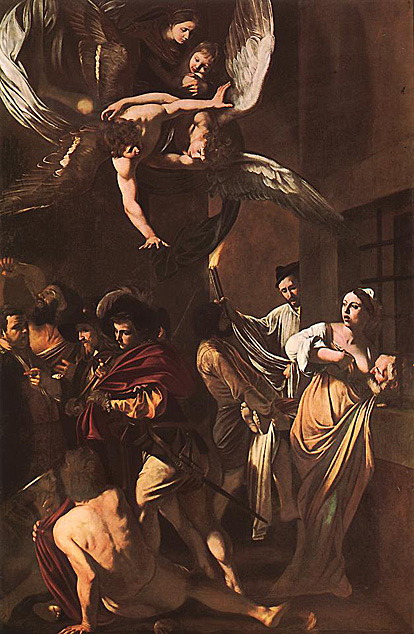
"From the fiefs of the Colonna family Caravaggio took refuge in Naples, in 1606. There he began to work again with his usual, astounding speed. Early in January 1607 he was paid for the immense altarpiece commissioned to him by the Pio Monte di Misericordia (where it may still be seen today). The painting shows the Seven Acts of Mercy. It is very complicated in its organization. Caravaggio actually had to add a series of figures (two angels and the Madonna and Child, the latter painted later) in the upper part of the painting, which make the composition of the picture the most complex, perhaps, in any of his works. Caravaggio did not paint exemplary episodes intended to stir the viewer to religious piety through the illustrative emphasis of gestures and feelings. Rather, he entrusted the educational effectiveness of his works to the evidence of things in themselves, in the conviction that nothing should be added above and beyond what is already contained in the intrinsic eloquence of the various poses."
“Painters don’t tell. Painters show. David Hockney’s breakthrough work on the use made by the old masters of mirrors and lenses is becoming well-known. Though there are carpers and hecklers, it has leapt from hunch, through theory, to accepted fact, in a remarkably short time. His basic idea, that lenses – effectively, photography without the chemical fixing – spread throughout European painting from the Renaissance onwards, alters for ever our own perception of some of the greatest artists in history. But if you recoil from it, Hockney doesn’t harangue or argue. He shows…. ”
Then the fun began. The more paintings Hockney studied, from the 1400s to the impressionists, the more evidence he thought he saw of other lenses being used. This is not to say that the greats of Western art – Durer, Holbein, van Eyck, Raphael, Caravaggio, Velazquez, Hals and many more – were ‘cheating’. Why is using a lens cheating, any more than using a plumb-line or a rule-book of mathematical perspective solutions? But they were certainly being helped with… well, with photography.
The idea that Vermeer used lenses – particularly a camera obscura for his famous view of Delft, but also for his interiors – has become reasonably familiar. And the circumstantial evidence for Caravaggio, who did no preliminary drawings, worked in a darkened cellar, and used the back of his brush to make very quick marks on a ground of wet paint, is extremely strong. Indeed, once you look at his lighting and foreshortening, which is very ‘photographic’, it’s obvious. But Hockney has pushed the argument far, far, further, spreading the use of lenses across four centuries and scores of other reputations. It is the biggest shift in our understanding of the old masters I can think of…. ( Andrew Marr )
But what we hadn’t known is how much lenses, particularly concave mirrors, were used to help draw and paint so realistically.
The same story applies to moving ones. Lenses, of course, show movement: the projections enjoyed by artists hundreds of years ago, Hockney told me, ‘are far better than high-definition television. In clarity and colour, they are amazing, they are ravishingly beautiful.’ But in the days of van Eyck or Caravaggio, they could not be preserved, except by drawing, a kind of note-taking. ‘They were living projections, meaning, if they are flowers, the flowers will die; if it’s a person, the person will move. But there’s no doubt that they saw colour images, optical projections which look like paintings. And they made paintings which look like optical projections.’ He chortles with delight at the thought. The old masters saw moving colour pictures – proto-television. It brings them closer, doesn’t it?



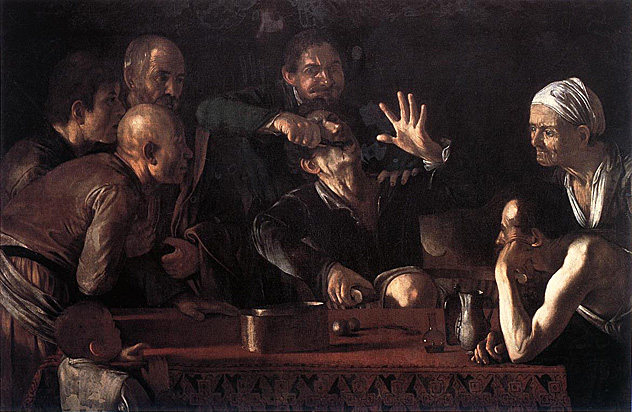




 COMMENTS
COMMENTS



